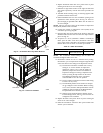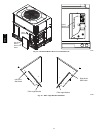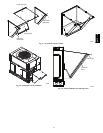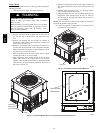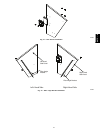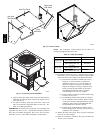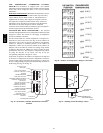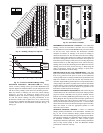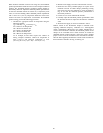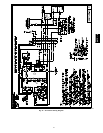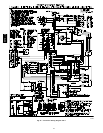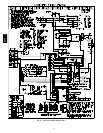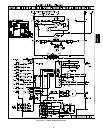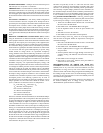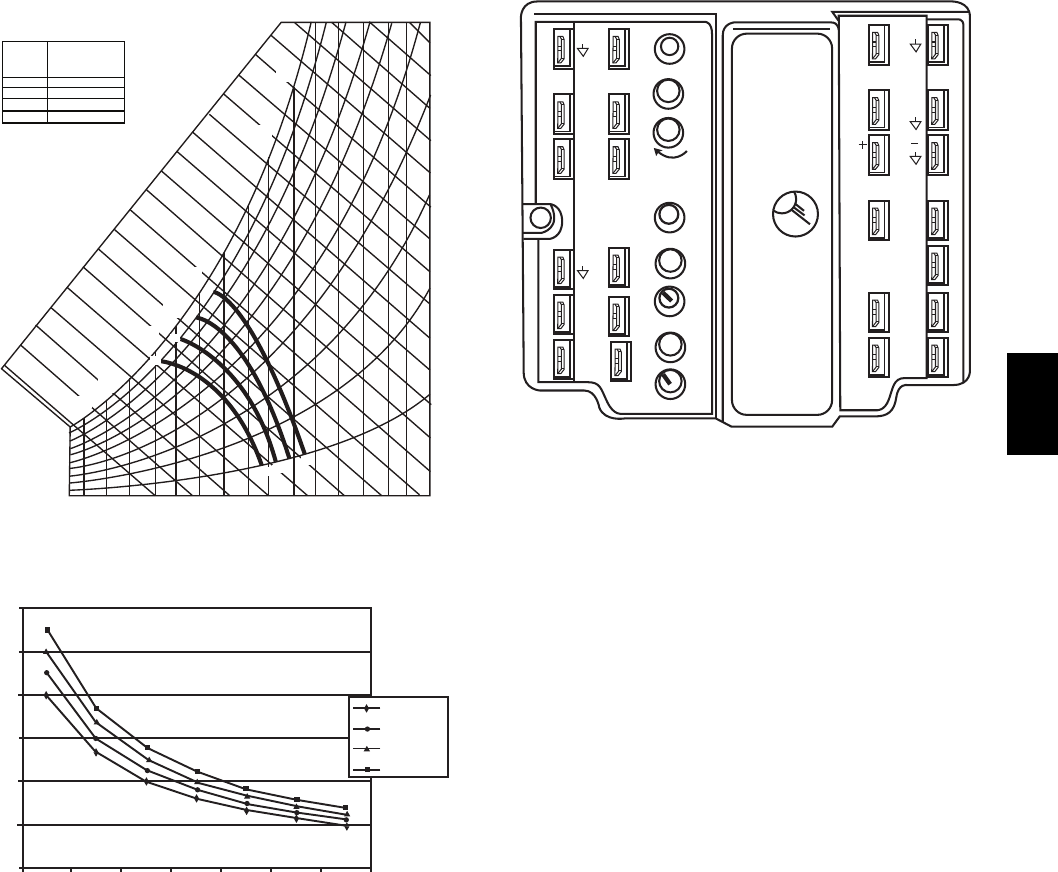
39
85
(29)
90
(32)
95
(25)
100
(38)
105
(41)
110
(43)
80
(27)
75
(24)
70
(21)
65
(18)
60
(16)
55
(13)
50
(10)
45
(7)
40
(4)
35
(2)
A
B
B
C
C
D
D
35
(2)
40
(4)
45
(7)
50
(10)
55
(13)
60
(16)
65
(18)
70
(21)
75
(24)
80
(27)
85
(29)
90
(32)
95
(36)
100
(38)
105
(41)
110
(43)
A
APPROXIMATE DRY BULB TEMPERATURE — ˚F (˚C)
ENTHALPY – BTU PER POUND DRY AIR
12
14
16
18
20
22
24
26
28
30
100
90
80
70
60
50
40
32
34
36
38
40
42
44
46
CONTROL
CURVE
CONTROL POINT
APPROX ˚F (˚C)
AT 50% RH
A 73 (23)
67 (19)
63 (17)
70 (21)
B
C
D
30
20
10
RELATIVE HUMIDITY (%)
A09711
Fig. 42 -- Enthalpy Changeover Setpoints
6000
5000
4000
3000
2000
1000
0
2345678
800 ppm
900 ppm
1000 ppm
1100 ppm
A09713
Fig. 43 -- CO
2
Sensor Maximum Range Setting
OUTDOOR ENTHALPY CHANGEOVER—For enthalpy
cont rol, accessory enthalpy sens or (part number HH57AC 078) is
required. Replace the standard outdoor dry bulb temperature sensor
with the accessory enthalpy sensor in the same m ounting location.
When the outdoor air enthalpy rises above the outdoor enthalpy
changeover set point, the outdoor--air damper moves to its
minimum position. The outdoor enthalpy changeover set point is
set with the outdoor enthalpy set point potentiometer on the
Economizer controller. The set points are A, B, C, and D. See Fig.
42. The factory--installed 620 --ohm jumper must be in place across
terminals SR and SR+ on the Economizer controller. See Fig. 44
and Fig. 45.
TR TR1
24
Vac
HOT
24 Vac
COM
12
5
43
EF1EF
C
10V
DCV
DCV
Max
DCV
DA
B
Set
2V
10V
10V
Min
Pos
2V
2V
Free
Cool
SR
SO
SO+
AQ+
T1
T
P
P1
N1
N
AQ
SR+
Open
EXH
Set
EXH
A09712
Fig. 44 -- Economizer Controller
DIFFERENTIAL ENTHALPY CONTROL — For differential
enthalpy control, the Economizer controller uses two enthalpy
sensors (HH57AC078 and CRENTDIF004A00), one in the outside
air and one in the return airstream. The Economizer controller
compares the outdoor air enthalpy to the return air enthalpy to
determine Economizeruse. Thecontroller selectsthe lowerenthalpy
air(returnoroutdoor)forcooling.Forexample, when the outdoorair
hasalowerenthalpy than the return airand isbelow theset point,the
Economizeropenstobringinoutdoorairforfreecooling.Replacethe
standard outside air dry bulb temperature sensor with the accessory
enthalpy sensor in the same mounting location. Mountthe return air
enthalpy sensor in the return air duct. See Fig. 41. When using this
mode of changeover control, turn the enthalpy set point poten-
tiometer fully clockwise to t he D setting.
INDOOR AIR QUALITY (IAQ) SENSOR INPUT —The IAQ
inputcan beusedfordemandcontrolventilation controlbased on the
level of CO
2
measured in the space or return air duct. Mount the
accessory IAQ sensor according to manufacturer specifications. The
IAQ sensor should be wired to the AQ and AQ1 terminals of the
controller.AdjusttheDCVpotentiometersto correspondtotheDCV
voltage output of the indoor air quality sensor at the userdeterm ined
set point.SeeFig.43. If aseparate field--supplied transformer isused
to power the IAQ sensor, the sensor must not be grounded or the
Economizer control board will be damaged.
EXHAUST SET POINT ADJUSTMENT—Theexhaust setpoint
will determine when the exhaust fan runs based on dampe r po sition
(if power exhaust is installed). The set point is modified with the
Exhaust Fan Set Point (EXH SET) potentiometer. See Fig. 45 for
Wiring Diagram. The set pointrepresentsthedamper pos ition above
which the exhaust fans will be turned on. When there is a call for
exhaust,theEconomizer controller providesa45 ± 15second delay
beforeexhaustfanactivation toallowthedamperstoopen.Thisdelay
allows the damper to reach the app ropriate position to a void
unnecessary fan overload.
MINIMUM POSITION CONTROL — There is a minimum
damper position potentiometer on the Economizer controller. See
Fig. 39 and 45. The minimum damper position maintains the
minimumairflowintothebuildingduringtheoccupiedperiod.When
using demand ventilation, the minim um damper position represents
the minimum ventilation position for VOC (vo latile organic
compound) ventilation requirements. The DCV Max potentiometer
must be fully clos ed (CCW) to allow the Minimum Position
pot entiometer t o function correctly.
607C-- --A



